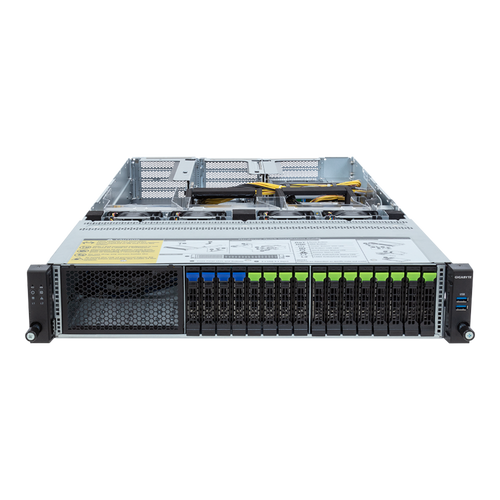Product Description
KEY FEATURE
- Supports up to 4 x Dual slot Gen5 GPUs
- Dual 5th/4th Gen Intel Xeon Scalable Processors
- Dual Intel Xeon CPU Max Series
- 8-Channel DDR5 RDIMM, 32 x DIMMs
- Dual ROM Architecture
- 12 x 3.5"/2.5" Gen5 NVMe/SATA/SAS-4 hot-swappable bays
- 4 x FHFL PCIe Gen5 x16 slots for GPUs
- 1 x FHHL PCIe Gen5 x16 slot
- 1 x OCP 3.0 Gen5 x16 slot
- Dual 2700W 80 PLUS Titanium redundant power supply
Servers Designed for Single-Phase Immersion Cooling
Specifically designed for immersion cooling solutions, and can be directly installed in GIGABYTE immersion cooling tanks or compatible with mainstream cooling tanks on the market. Eliminate the need for product compatibility testing and customization. These systematic modifications greatly reduce the time for verification and adoption of immersion cooling technology.
Design to Ensure Steady Fluid Flow in the Tank
When a server is submerged in a coolant, an important condition is that the fluid is circulated well, and the warm fluid is pumped out as cooler fluid is pumped in. Only by maintaining a stable coolant flow can the heat absorbed by the fluid be managed, and the system can automatically adjust the coolant flow rate according to the operation needs. To ensure efficient heat removal, the server design for single-phase immersion cooling not only must remove any components that negatively affect the fluid flow in the system, but they also must reduce the dead space in the chassis to avoid heat accumulation. Based on the viscosity of the coolant and the specific heat capacity of the coolant, the heat dissipation rate of the server must be constantly monitored and adjusted to avoid issues . Servers developed for single-phase immersion cooling can significantly reduce unnecessary barriers that users may encounter when adopting new technologies, allowing them to focus on productivity.
Structural Integrity and Simplified Management
Servers must be installed vertically in the tank, and this lowering or raising of servers is due to an optimized tank design for single-phase immersion cooling. Therefore, the server installed upright needs to have rigid and firm structural integrity to ensure the chassis will not deform. Also, due to the vertical design, the cable routing and maintenance are also different than traditional data centers. Therefore, we re-examine the design and strengthen the server chassis for immersion cooling and reroute the cables. For instance, I/O ports are all arranged on the rear side facing up, and the network cables need to be rerouted to the sides so that maintenance can be quick and easy. Also, to make it more convenient for IT to install or remove a server, a bracket was added to allow hooks to move the server.
Made with Materials Suitable for Various Coolants
Single-phase immersion cooling submerges the server in a cooling fluid that removes heat by directly coming into contact with the heating elements. GIGABYTE had to evaluate how the chemical composition of the coolant may affect the components as well as the effect of the temperature and process on the coolant. Through theory and experimental experience, we perfected the design and will continue to explore materials that are suitable for immersion cooling.
Accelerating Artificial Intelligence and Leading Efficiency
Engineering richer features in a revolutionary platform, Intel has made an incredible jump in processor performance in the business transformation journey. AI and deep learning performance will benefit from the built-in AI acceleration engines, while networking, storage, and analytics leverage other specialized accelerators in the 4th & 5th Gen Intel Xeon Scalable processors. Adding a host of new features to target a wide range of workloads, the new families of Intel Xeon processors will deliver even better CPU performance and performance per watt, and do so on a PCIe 5.0 platform with 2x the prior gen throughput to greatly speed up data movement to and from GPUs and storage. Intel also created the Intel Xeon CPU Max Series with High Bandwidth Memory (HBM) for improvements in memory bound HPC and AI workloads. For this new platform, GIGABYTE has products ready to get the most out of Intel Xeon CPU-based systems that support fast PCIe Gen5 accelerators and Gen5 NVMe drives, in addition to support for high performant DDR5 memory.
Acceleratorsbuilt-in*
Increase ROI while improving efficiency and performance
Up to 64cores
More tasks can be done simultaneously and faster with dedicated cores
DDR5support
Increased memory frequency and throughput with DDR5 RDIMM support
64GBHBM**
High bandwidth in-package memory massively speeds up data-intensive workloads
PCIe 5.0lanes
Increased I/O throughput achieving 128GB/s bandwidth with support for the latest drives and accelerators
CXL 1.1support
Improve performance via memory coherency and direct accelerator memory access
Select GIGABYTE for the latest Gen Intel Xeon Platform
High CPU Performance
The best in computational performance relies on a system well designed by our engineers to adequately dissipate heat to achieve peak performance.
Energy Efficiency
Our engineers have baked in features to achieve higher efficiency from power supplies and server fans. Along with Titanium and Platinum offerings.
Optimal Price
GIGABYTE releases multiple product models and configurations to target exactly what users want without paying for extra features that go unused.
Ease of Administration
GIGABYTE servers come with GIGABYTE Management Console for server management. Using a web based browser remotely is key to easing management.
Continuous Operation
Systems are rigorously designed and tested to ensure downtime will not occur. Customers have come to expect stable performance.
High Availability
Smart Ride Through (SmaRT)
To prevent server downtime and data loss as a result of loss of AC power, GIGABYTE implements SmaRT in all our server platforms. When such an event occurs, the system will throttle while maintaining availability and reducing power load. Capacitors within the power supply can supply power for 10-20ms, which is enough time to transition to a backup power source for continued operation.
Smart Crises Management and Protection (SCMP)
SCMP is a GIGABYTE patented feature which is deployed in servers with non-fully redundant PSU design. With SCMP, in the event of faulty PSU or overheated system, the system will force the CPU into an ultra-low power mode that reduces the power load, which prevents the system from unexpected shutdown and avoids component damage or data loss.
Dual ROM Architecture
If the ROM that stores the BMC and BIOS fails to boot, the system will reboot with the backup BMC and/or BIOS replacing the primary. Once the primary BMC is updated, the ROM of the backup BMC will automatically update the backup through synchronization. For the BIOS, it can be updated based on user's choice of firmware version.
Hardware Security
Optional TPM 2.0 Module
For hardware-based authentication, the passwords, encryption keys, and digital certificates are stored in a TPM module to prevent unwanted users from gaining access to your data. GIGABYTE TPM modules come in either a Serial Peripheral Interface or Low Pin Count bus.
User Friendly
Tool-less Drive Bays Design
Clipping mechanism secures the drive in place. Install or replace a new drive in seconds.
OCP 3.0 Ready
GIGABYTE offers servers that feature an onboard OCP 3.0 slot for the next generation of add on cards. Advantages of this new type include:
- Easy Serviceability:
Simply slot in or pull out the card, without opening the server or using tools - Improved thermal design:
Horizontal position and optimal heat sink design allow for air cooling to eliminate the heat efficiently
Certified Ready with Software Partners
Being a member of key software alliance partner programs enables GIGABYTE to rapidly develop and validate joint solutions, enabling our customers to modernize their data centers and implement IT infrastructure and application services with speed, agility, and cost optimization.
Value-added Management
GIGABYTE offers free-of-charge management applications via a specialized small processor built on the server.
GIGABYTE Management Console
For management and maintenance of a server or a small cluster, users can use the GIGABYTE Management Console, which is pre-installed on each server. Once the servers are running, IT staff can perform real-time health monitoring and management on each server through the browser-based graphical user interface. In addition, the GIGABYTE Management Console also provides:
- Support for standard IPMI specifications that allows users to integrate services into a single platform through an open interface
- Automatic event recording, which can record system behavior 30 seconds before an event occurs, making it easier to determine subsequent actions
- Integrate SAS/SATA/NVMe devices and RAID controller firmware into GIGABYTE Management Console to monitor and control Broadcom MegaRAID adapters.
GIGABYTE Server Management (GSM)
GSM is a software suite that can manage clusters of servers simultaneously over the internet. GSM can be run on all GIGABYTE servers and has support for Windows and Linux. GSM can be downloaded from GIGABYTE website and complies with IPMI and Redfish standards. GSM includes a complete range of system management functions that includes the following utilities:
- GSM Server: A software program that provides real-time, remote control using a graphical user interface through an administrator’s computer or through a server in the cluster. The software allows ease of maintenance for large clusters of servers.
- GSM CLI: A command-line interface for monitoring and managing remotely.
- GSM Agent: A software program installed on each GIGABYTE server node that retrieves information from each system and devices through the OS, and this software integrates with GSM Server or GSM CLI.
- GSM Mobile: A mobile app for both Android and iOS that provides admins with real-time system information.
- GSM Plugin: An application program interface that allows users to use VMware vCenter for real-time monitoring and management of server clusters.
 US Dollars
US Dollars
 United Arab Emirates Dirham
United Arab Emirates Dirham
 Euro
Euro
 British Pound
British Pound
 Turkish Lira
Turkish Lira
 Canadian Dollar
Canadian Dollar
 South African Rand
South African Rand
 Indian Rupee
Indian Rupee
 Brazilian Real
Brazilian Real
 Indonesian Rupiah
Indonesian Rupiah
 Singapore Dollar
Singapore Dollar
 South Korean Won
South Korean Won
 Japanese Yen
Japanese Yen
 Chinese Yuan
Chinese Yuan
 Mexican Peso
Mexican Peso
 Qatari Rial
Qatari Rial
 Saudi Riyal
Saudi Riyal




















